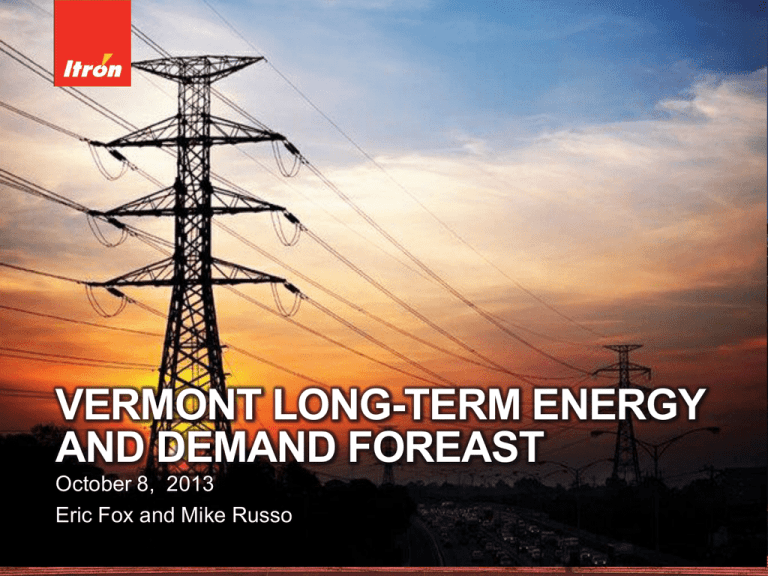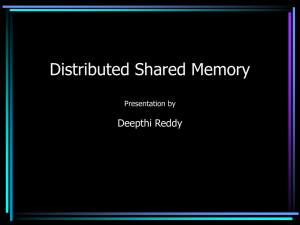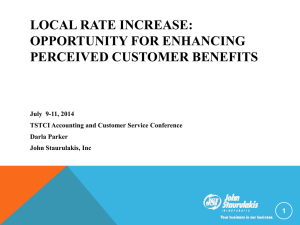ITRON VT Long-Term & Demand Forecast
advertisement

VERMONT LONG-TERM ENERGY AND DEMAND FOREAST October 8, 2013 Eric Fox and Mike Russo AGENDA » » » » Recent Sales and Customer Trends Preliminary State Sales and Demand Forecast Building a No DSM Forecast End-Use Saturation Projections Integrating the New Appliance Saturation Survey » Estimating Solar Load Impacts VELCO SYSTEM ENERGY 2003 TO 2013 Year Energy (GWh) 2003 6,285 2004 6,390 2005 6,523 2006 6,473 2007 6,536 2008 6,419 2009 6,143 2010 6,209 2011 6,204 2012 6,175 2013 6,252 chg 2003 - 2007 2007 - 2013 2003 - 2013 chg Wthr Nrm Energy 6,209 1.7% 6,395 2.1% 6,426 -0.8% 6,544 1.0% 6,489 -1.8% 6,424 -4.3% 6,195 1.1% 6,207 -0.1% 6,204 -0.5% 6,192 1.3% 6,226 chg 3.0% 0.5% 1.8% -0.8% -1.0% -3.6% 0.2% 0.0% -0.2% 0.5% 1.0% -0.7% 0.0% 1.1% -0.7% 0.0% * 2013 – 7 mo actual /5 mo forecast While sales have been flat over the last ten years There have been two distinct periods – before and after the recession VELCO SYSTEM PEAK DEMAND Year 2003 2004 2005 2006 2007 2008 2009 2010 2011 2012 2013 chg 2003 - 2007 2007 - 2013 2003 - 2013 System Peak 1,000.7 984.9 1,073.6 1,126.5 1,072.6 1,048.4 1,016.5 1,068.7 1,062.2 1,007.0 1,060.7 chg -1.6% 9.0% 4.9% -4.8% -2.3% -3.0% 5.1% -0.6% -5.2% 5.3% 1.9% -0.1% 0.7% WN Peak 1,034.1 1,070.8 1,063.4 1,108.0 1,077.4 1,068.2 1,020.2 1,040.5 1,057.2 999.2 1,036.5 chg 3.5% -0.7% 4.2% -2.8% -0.9% -4.5% 2.0% 1.6% -5.5% 3.7% 1.1% -0.6% 0.1% *WNLF_Peak = WN Energy / WN Peak Load Factor System peak shows a similar pattern Positive growth in 2013 WNLF_Peak 1,033.6 1,064.7 1,069.8 1,089.5 1,080.3 1,069.4 1,031.4 1,033.4 1,032.9 1,030.9 1,036.6 chg 3.0% 0.5% 1.8% -0.8% -1.0% -3.6% 0.2% 0.0% -0.2% 0.5% 1.1% -0.7% 0.0% PEAK-DAY TEMPERATURES 2013 was the hottest peak day in 11 years. Second hottest day based on a 3-day weighted THI GMP YEAR TO DATE SALES January through August Residential Commercial Industrial Total Weather Normalized GMP Sales YTD 13 YTD 12 1,067,772 1,063,989 1,038,187 1,031,016 502,694 498,188 2,608,653 2,593,193 Difference 0.4% 0.7% 0.9% 0.6% Residential Commercial Customers YTD 13 219,978 38,145 YTD 12 218,458 37,798 Difference 0.7% 0.9% Residential Commercial Avgerage Use YTD 13 4,854 27,217 YTD 12 4,870 27,277 Difference -0.3% -0.2% Vermont Economic Growth YTD 13 YTD 12 259,891 258,731 306,140 302,568 Difference 0.4% 1.2% Households Employment Beginning to see some sales and customer growth with improving economy SYSTEM FORECAST APPROACH Sales & Customers Weather Conditions Economic Drivers Electric Prices Customer Class and End-Use Energy Forecast Structural Changes DSM System Hourly Load Peak-Day Weather System Energy and Peak Forecast End-Use CP Factors System Profile Solar Load and EVs Demand Response System Hourly Load Forecast Residential and Commercial Sales Forecasted using a SAE Modeling Framework SAE MODELING FRAMEWORK KEY FORECAST DRIVERS » Economic activity and population growth • Moody Analytics Vermont economic forecast » Weather conditions • Twenty-year normal HDD and CDD » Price projections » End-Use Intensity Projections • Saturation forecast – Vermont appliance saturation surveys • Baseline efficiency projections – 2013 AEO » Intensity adjustments for state efficiency programs » Residential and commercial solar net metering system market penetration » Electric vehicles » ??? PRELIMINARY VERMONT ENERGY AND DEMAND FORECAST » Revenue class sales and customer data through March 2013 » Moody Analytics June 2013 economic forecast for Vermont » 2012 end-use intensity projections • Reflects the 2012 VEIC efficiency savings projections » No solar load adjustment » No price impacts Used as a basis for developing a No DSM Forecast BASELINE END-USE INTENSITY TRENDS » End-use intensity trends reflect both saturation and average stock efficiency improvements » Current intensity trends reflect KEMA state saturation survey, EIA New England forecasts, and past BED appliance saturation surveys 2,000 1,800 Heating 1,600 Cooling EWHeat 1,400 ECook Ref1 kWh 1,200 Ref2 1,000 Frz Dish 800 CWash 600 EDry TV 400 Light 200 Misc 0 2005 2006 2007 2008 2009 2010 2011 2012 2013 2014 2015 2016 2017 2018 2019 2020 2021 2022 2023 DSM ADJUSTED END-USE INTENSITIES » Develop baseline end-use sales forecast from SAE models » Calculate adjusted end-use sales forecasts for DSM savings projections • Residential: assume 75% is embedded in the baseline forecast • Commercial: assume 50% is embedded in the baseline forecast » Adjust end-use intensity forecasts to reflect DSM savings adjustments DSM embedded assumptions based on calibration to actual sales DSM ADJUSTED WATER HEATING INTENSITY 850 Baseline 800 700 Adjusted 650 600 550 2022 2021 2020 2019 2018 2017 2016 2015 2014 2013 2012 2011 2010 2009 2008 2007 2006 500 2005 kWh 750 TOTAL END-USE INTENSITY PROJECTIONS 8,400 Baseline 8,200 7,800 7,600 Adjusted 7,400 7,200 7,000 Residential 11.00 2012 2013 2014 2015 2016 2017 2018 2019 2020 2021 2022 Baseline 10.50 10.00 kWh per sqft kWh 8,000 9.50 Adjusted 9.00 8.50 Commercial 8.00 2010 2011 2012 2013 2014 2015 2016 2017 2018 2019 2020 2021 2022 2023 RESIDENTIAL AVERAGE USE COMPARISON 9,500 9,000 New England 8,500 7,500 Vermont (with DSM) 7,000 6,500 6,000 5,500 2003 - 13 2013 - 23 New England -0.4% 0.0% Vermont -0.9% -0.9% 5,000 2003 2004 2005 2006 2007 2008 2009 2010 2011 2012 2013 2014 2015 2016 2017 2018 2019 2020 2021 2022 2023 kWh 8,000 DEVELOPING THE “NO DSM” FORECAST » Adjust end-use intensities upwards – add back in 100% of projected DSM savings • Assume no future DSM is embedded in the baseline forecast No DSM 2,600 2,400 No DSM 2,400 Residential 2,200 2,200 Commercial 2,000 GWh GWh 2,000 1,800 1,600 1,400 1,200 1,000 2003 - 2013 2013 - 2032 No DSM -0.2% 1.0% With DSM -0.2% -0.1% 1,800 1,600 1,400 1,200 1,000 2003 - 2013 2013 - 2032 No DSM 0.3% 1.5% With DSM 0.3% 0.5% RESIDENTIAL AVERAGE USE No DSM With DSM 2003 - 2013 2013 - 2032 No DSM -1.0% 0.4% With DSM -1.0% -0.9% COMMERCIAL AVERAGE USE 50,000 45,000 No DSM kWh 40,000 35,000 With DSM 30,000 25,000 2003 - 2013 2013 - 2032 No DSM -1.0% 0.5% With DSM -1.0% -0.5% 20,000 2003 2004 2005 2006 2007 2008 2009 2010 2011 2012 2013 2014 2015 2016 2017 2018 2019 2020 2021 2022 2023 VERMONT ENERGY REQUIREMENTS 7,000 No DSM 6,500 GWh 6,000 With DSM 5,500 5,000 4,500 4,000 2003 - 2013 2013 - 2032 No DSM -0.4% 1.0% With DSM -0.4% 0.0% 2003 2004 2005 2006 2007 2008 2009 2010 2011 2012 2013 2014 2015 2016 2017 2018 2019 2020 2021 2022 2023 VERMONT PEAK DEMAND 1,200 1,100 No DSM 1,000 With DSM MW 900 800 700 2003 - 2013 2013 - 2032 No DSM 0.4% 1.0% With DSM 0.4% -0.1% 600 By 2023, DSM programs reduce peak demand by 119 MW (10%) 500 2003 2004 2005 2006 2007 2008 2009 2010 2011 2012 2013 2014 2015 2016 2017 2018 2019 2020 2021 2022 2023 UPDATING END-USE SATURATION ESTIMATES » Incorporate new appliance saturation survey information • NMR 2012 Residential Home Survey (Reported February 2013) » Also have the KEMA 2005 survey, earlier BED survey, and the EIA estimates for New England » We were hoping to connect the dots between the KEMA and NMR survey • Problem: The two survey points are not all that consistent ELECTRIC HEAT KEMA NMR Surveys show consistently lower shares than that implied by the billing data ELECTRIC HEAT CUSTOMER SHARE AND USE EH_CustShare 20.0% 18.0% 16.0% 14.0% 12.0% 10.0% 8.0% There appears to be significant electric heating 6.0% 4.0% EH_AvgUse 2.0% NEH_AvgUse 1,600 0.0% 2001 2002 2003 2004 2005 2006 2007 2008 2009 2010 2011 2012 1,400 kWh/customer 1,200 1,000 800 600 400 200 0 2001 2002 2003 2004 2005 2006 2007 2008 2009 2010 2011 2012 SECONDARY ELECTRIC HEAT NMR KEMA Could be people with electric heat consider it a back-up source CENTRAL AIR CONDITIONING NMR KEMA 2 out of 3 sources say CAC saturation is higher ROOM AIR CONDITIONING KEMA NMR Reported RAC saturation is about the same but not consistent with the BED saturation growth ELECTRIC WATER HEATING KEMA NMR KEMA and NMR diverge from New England water heating saturation trends SECOND REFRIGERATORS KEMA NMR NMR saturation is more consistent with New England FREEZERS KEMA NMR The two surveys imply an unlikely sharp decline in the number of freezers CLOTHES WASHERS KEMA NMR DRYERS KEMA NMR NMR survey closer to that reported by EIA DISH WASHERS KEMA NMR KEMA survey closer to that reported by EIA PV MARKET PENETRATION » Though still relatively small net metering (particular residential and commercial photovoltaic systems) has been growing quickly Share of customers with PV systems (GMP solar customer data) Residential Commercial Through 2012 FACTORS DRIVING NET METERING PENETRATI0N » Federal Investment Incentives – Through 2017 • 30% of system installed cost » State Investment Incentives • Was $0.45 per watt now $0.25 per watt • On a 5 kW system incentive drops from $2,250 to $1,250 - But federal absolute dollar credit will offset some of this » High avoided electric rates • average residential rate $0.16 per kWh » Generous buy-back rate • Credit equal to $0.20 per kWh (retail rate plus $0.04 per kWh) SOLAR LOAD IS HAPPENING WHERE STATE INCENTIVES ARE SIGNIFICANT SHOULD SEE STRONG PV MARKET GROWTH $9.00 $8.00 $7.00 $6.00 $5.00 $4.00 $3.00 $2.00 $1.00 $- Assumes 10% annual decline in system cost 2008 2009 2010 2011 2012 2013 2014 2015 2016 2017 2018 2019 2020 2021 2022 16.0 14.0 12.0 Assumes continuation of federal tax credit 10.0 8.0 6.0 4.0 2.0 - Simple Payback RESIDENTIAL SIMPLE PAYBACK MODEL Variable CONST Payback LagShare Adjusted Observations Deg. of Freedom for Error R-Squared Adjusted R-Squared Mean Abs. % Err. (MAPE) Durbin-Watson Statistic Coefficient 0.0008 -0.00005 0.97447 44 40 0.998 0.997 2.30% 1.758 T-Stat 1.886 -1.673 36.929 P-Value 6.66% 10.22% 0.00% RESIDENTIAL PV MARKET PENETRATION FCST Base Case No Federal Tax Credit No State or Federal Tax Credit RESIDENTIAL AND SOLAR CUSTOMER FORECAST Year 2012 2013 2014 2015 2016 2017 2018 2019 2020 2021 2022 ResCusts 308,967 312,543 314,006 317,079 320,383 323,462 326,240 328,748 331,226 333,468 335,488 chg 1.2% 0.5% 1.0% 1.0% 1.0% 0.9% 0.8% 0.8% 0.7% 0.6% SolarCusts 2,023 2,816 3,530 4,193 4,813 5,386 5,909 6,385 6,819 7,214 7,570 chg 39.2% 25.4% 18.8% 14.8% 11.9% 9.7% 8.1% 6.8% 5.8% 4.9% Shr Solar 0.7% 0.9% 1.1% 1.3% 1.5% 1.7% 1.8% 1.9% 2.1% 2.2% 2.3% RESIDENTIAL GENERATION AND USE Average kWh per month Generated 6,700 kWh per year Own Use 5,200 kWh per year Billed Average Use 6,680 kWh per year RESIDENTIAL SOLAR LOAD FORECAST Year 2012 2013 2014 2015 2016 2017 2018 2019 2020 2021 2022 Generated (MWh) 13,554 18,867 23,651 28,093 32,247 36,086 39,590 42,780 45,687 48,334 50,719 Used (GWh) 10,520 14,643 18,356 21,804 25,028 28,007 30,727 33,202 35,459 37,513 39,364 Capacity (MW) 9.1 12.7 15.9 18.9 21.7 24.2 26.6 28.7 30.7 32.5 34.1 Capacity estimated using a 0.17 load factor, assume average system size = 4.5 Mw






